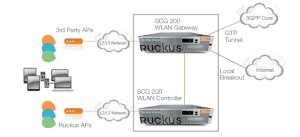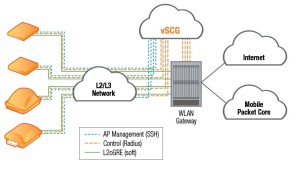 Summary: Ruckus Wireless, the industry leading WLAN OEM, has taken big leap, by offering WLAN controller in ‘Cloud’, thereby reducing the complexity of deploying Carrier Class Wi-Fi. The development would help Wi-Fi Managed Service providers, in deploying Carrier grade Wi-Fi equipment, at public hotspots, SM enterprises & other venues, for hassle free ‘Management’ functionality over ‘Cloud’.
Summary: Ruckus Wireless, the industry leading WLAN OEM, has taken big leap, by offering WLAN controller in ‘Cloud’, thereby reducing the complexity of deploying Carrier Class Wi-Fi. The development would help Wi-Fi Managed Service providers, in deploying Carrier grade Wi-Fi equipment, at public hotspots, SM enterprises & other venues, for hassle free ‘Management’ functionality over ‘Cloud’.
Ruckus Wireless, the company behind India’s Rapid Metro Wi-Fi, is bringing more innovation to Wi-Fi Service providers & Enterprises. The company, in recent release, has come up with first of its kind vSCG (Virtual Smart Cell Gateway), which is WLAN Controller & Gateway in a box with difference- the box is virtual & resides in ‘Cloud’.
So what’s this vSCG and why should you bother about it? Ruckus already offers SCG-200, a Smart Cell Gateway solution, which is Carrier class WLAN Controller with WLAN Gateway support in-built. In other words, SCG-200 offers all the functions of a typical Carrier (or even enterprise) WLAN Controller & WLAN Gateway combined, in a single box. India’s leading telecom operator, Bharti Airtel, has already deployed SCG-200 recently at their Bangalore Data Center.

But understand that ‘SCG-200’ is a hardware box & needs to be installed at service provider’s centralized data center facility. So in a typical scenario, where a service provider has deployed tens of thousands of Wi-Fi hotspots geographically distributed at various cities, the SCG-200 would form a single interface for management of those hotspots (Controller managing Access points) & also simultaneously form Gateway to 3GPP Packet Core. In general, SCG-200 can manage up to 10,000 APs (Ruckus & non Ruckus both) and can support thousands of subscribers with excess of 20 Gbps throughput. And the best part is; it already supports Hotspot 2.0 standard for seamless Wi-Fi roaming experience.
With vSCG, Ruckus has taken this box into Cloud with one difference. Now, as control plane reside in Cloud (Controller), the data traffic is being carried out by separate WLAN Gateway. So with virtualization, the controller functionality of earlier SCG-200 resides in cloud, the WLAN Gateway still remains as hardware box, which would route the data traffic towards 3GPP Packet core & Internet.
Why is this important? First of all, it simplifies network deployment & management plane architecture. Now take the example of Bharti Airtel, who is deploying tens of thousands of Ruckus APs across various cities in India. With vSCG, Bharti doesn’t have to bother about Wi-Fi controller as a hardware box, interfaced with thousands of APs to manage & control. So everything from ‘Control’ plane now becomes virtual, all you need to do is to route the data traffic emerging from clusters of APs via WLAN gateway, either towards 3GPP Packet core or towards Internet directly.

Second best part would be ‘Cost’. Now all of a sudden WLAN Controller is moved to ‘Cloud’ or becomes virtual the total cost of deployment is surely going to be low as compared to SCG-200 based deployment. Ruckus specifies the vSCG deployment on VMWare vSphere hypervisor, where VMs (Virtual Machines) are created for running vSCG.
How much load/traffic can this vSCG handle? At the moment, Ruckus says that as traffic increases, vSCG can take additional hardware resources from underlying VMWare Hypervisor we still need to figure out, how effective that would be. But certainly, it would be interesting to see vSCG replacing SCG-200 in certain scenarios to start with, especially those Enterprise deployments, where APs are deployed at premises, which can be managed from ‘Cloud’ based platforms like vSCG.
One thing is clear, we need scale to deploy vSCG or for that matter SCG-200. While telecom operators in India, barring Bharti, are still in initial stage of deployment of Wi-Fi hotspots across India, the traffic emerging or getting offloaded from these APs is still very low to justify deployment of vSCG. The Wi-Fi traffic, emerging from these hotspots can be managed by separate WLAN Controller hardware boxes, deployed at Packet Core side of typical Opco core network. The Wi-Fi neutral host players like Ozone or couple of big ISPs, can evaluate the option of deploying vController based solution, but at the moment, we need Ruckus AP based deployment to manage them through ‘Cloud’. Although SCG-200 can manage cluster of other APs, including Cisco, Aruba, vSCG does require to go with Ruckus based AP deployments only.

